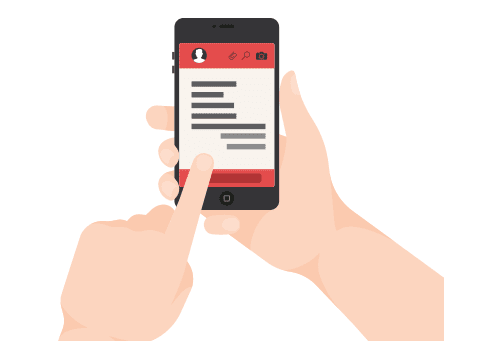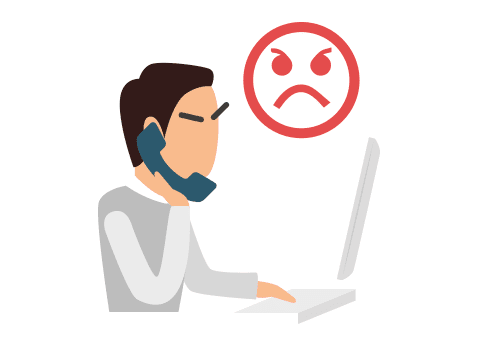In some way, anyone who has had contact with anyone at a commercial level is aware that the vast majority of people need some kind of help, advice, or clarification to encourage them to finally make a purchase.
And that, in fact, on many occasions, this factor determines whether they buy or not. In other words, if they are not well attended to, they will most likely not buy anything in the end. An online store must be aware of the importance of its customer support service, as this will determine its future image as a company.
Table of contents
Customer service, a determining factor in the buying decision
The website econsultancy, according to LivePerson statistics based on a survey of 5,700 consumers in the United Kingdom, the United States, Australia, France, Germany and Italy, has determined the importance of the right customer service, and has obtained some rather surprising data.

83% of online shoppers admit to needing some kind of support or help during the purchase process. One of the main reasons for consumers abandoning sites is that when they need to solve a question regarding their purchase, they do not receive adequate assistance. The report contains some interesting data, such as:
Reasons for abandonment of purchasing processes:
Online shoppers as it is already known are very demanding, so if they do not find the information about a product they want, they will abandon the process and go to a competitor’s store. Therefore, sites must provide support at this point, such as the possibility of live chatsaccording to the report, the main reasons for abandoning the purchase process are unexpected shipping costs (70%) or lack of information about the product, service or delivery (50%). Not finding an answer to a question (37%) or the difficulty of obtaining help on the website (30%) also influence abandonment.
Customer expectations:
As we commented above, 83% of online shoppers claimed to need some kind of support or assistance during their purchase. For those with little online shopping experience, this percentage rises to 90%. More than half of shoppers (51%) either tried once or immediately gave up on the purchase when seeking help, particularly in Germany (57%), the UK (55%) and Australia (36%). Once the purchase has been made, buyers are willing to persist in trying to get a problem solved, with 76% trying at least twice to solve it. In this sense, 71% of customers expect to receive help within five minutes; if they do not get it, 48% of them will abandon the site. This figure rises in the case of the UK to 58%.
how do customers want to be helped?
Despite not having the best reputation, the telephone remains the most popular source of help for online consumers (61%), closely followed by email (60%). Fifty-seven percent of them want to be served by live chats, 51% by FAQs and 34% by click-to-call.

what can we do to improve our customer service?
While it is true that it is more difficult to achieve customer loyalty in a constantly updated digital environment, where it is always possible to find better offers than the ones we offer, it is also true that certain aspects, minimal, that seem small, can make a big difference in this environment.
The customer is used to the aseptic treatment of multinationals, to having to deal with employees of outsourced companies who know absolutely nothing about you unless you provide them with a specific order number, and when he suddenly finds a personal, differentiated and attentive treatment, he is not only surprised, but becomes an advocate and, in the long run, a small-scale influencer of your own brand.
1. Visualize faces, not numbers.
Or, to put it another way, put yourself in the shoes of every person who comes to you for help or to file a complaint, because the business is in the customer rather than the product or service itself. Think about how you would want to be treated if you were in their shoes and whether you would want them to behave towards you in the same way that you behave towards them: do you consider the outcome to be satisfactory, pleasant and professional? If so, you will be doing a good job. If not, you may need to rethink your protocol and even your communication skills. Be polite, really listen to everything they have to tell you and don’t just give standard answers based on a predefined script. Try to get to know the individual who has contacted the helpdesk beyond the statistics and numbers that make up their profile. Don’t get into arguments, because it’s not about imposing your reason over theirs. And, if you are the owner of the company, remember that you must foster an environment full of happy workers so that this good feeling is transmitted to the outside world.
2. Be accessible (at all times and in multiple places).
One of the keys to pleasing your customers will be how easy it is to find you. This means, first and foremost, having a customer service team that operates as long as possible. Of course, it also means that we are dealing with a unit that is essential for the proper functioning of the company and that, depending on the size of the company, may require a significant volume of personnel and a reasonable investment of money. On the other hand, it is advisable to complement the traditional telephone system with messaging chats, to talk in real time with the person concerned, and even with social networks, which have everything to become perfect allies of customer service, such as immediacy and ease of use. To this we must add a clear web page containing a FAQs section with answers to the main doubts of users, which can save them a lot of time, and your contact details.
3. what language do you speak?
Your customers may not necessarily be familiar with certain technical terms or how your products or services work at a different level than the average user, so speak clearly. Explain the situation in a simple way (but don’t leave out important details) and don’t overwhelm them with a speech full of complicated, hard-to-understand jargon that makes them feel ignorant. Use analogies, adapt to your interlocutor and open your ears to try to understand what he or she is trying to explain, as sometimes a misunderstanding or a different way of referring to the same thing can lead to a breakdown in the resolution of the conflict. It is equally important not to make empty promises and not to beat around the bush, transparency is essential in this profession: do not be afraid to admit that you are unable to meet certain requests (if they are really impossible to meet) and do not be afraid to admit your failures, which brings us to the next point.

4. Admit your mistakes.
Everyone makes mistakes and the worst thing you can do is try to hide them. Whether the failure was caused by you or by another colleague in your company, or if there has been a setback that affects your business and therefore your customers, such as a server crash, a defect in a part contained inside your devices or a billing error, you must make it public. It will always be more positive for your users or consumers to hear it from you than from third parties, since being honest will serve to reinforce your image even in adversity and strengthen the bonds of trust. When you detect a problem in your business, therefore, you should alert your customers and offer an apology, undertake an investigation to remedy it and ensure that it will never happen again, and provide an address or contact number so that people know who to turn to in case there are any unresolved questions. Alternatively, offer a discount on a future purchase or provide a refund for the product or service purchased.
5. Reward loyalty.
It is neither necessary, nor advisable, to wait only for a screw-up to reward your customers and, above all, their loyalty. Why not take advantage of other special occasions to spread “happiness”? The anniversary of a service subscription, for example, is an ideal occasion to run promotions or give away free premium days before the expiration date, especially if your customers are still thinking about whether or not to renew their accounts. A detail like this, in addition to rewarding their trust in your company in the past, can represent the definitive push they need to continue doing so in the future. Taking the initiative in cases like this serves, without a doubt, to establish a positive interaction and feed the word of mouth in your favor. The detail does not even have to be excessively large, from a coupon to additional information or curious tips on how to use a product, through a simple smile, will serve to make your customers happy.

Customer service in e-Commerce
When you have a store in a physical location, it is more or less clear to you what your tasks are in terms of customer service. You know that you have to greet them, or at least ask them if you can help them with something if they have been wandering or looking around the store for a while. Advise him on a product from our stock, depending on the customer’s needs.
Attend the cash register one by one to each person in the queue. If a customer comes with a product to return (probably because they don’t like it or they have given it as a gift and already have it, since in a physical store it is difficult to give a defective product or one that does not correspond to what the customer has ordered, since they have seen it and tried it and, generally, they take the same one), we simply process the return with the purchase receipt, and we change it for something else or refund the money (this depends on the conditions of each business).
If a customer has any doubts, then he approaches you or any of the people who work with you, and that’s it. Let’s say that everything is more evident and controllable for the simple reason that we move in a physical environment and direct interaction with our public; however, in online commerce, all this is much more opaque, impersonal and indirect than we could have imagined.
To begin with, we do not have opening hours, everything is 24/7, so we will have to be aware all day long of the orders that are arriving and process them as they appear (it is proven that the highest rate of online purchases occur on weekends, which is when people are at leisure and have time to shop), so if our idea is to “close the shutter” on Friday afternoon and not open it again until Monday morning, what we will find is a queue of tickets and orders that will take us a good part of the day to catch up, which will make us accumulate more tickets and unresolved tasks..a loop of overwhelm and haste that makes things not go as they should.
Let’s focus and try to make clear the tools we have to address the customer service of our ecommerce.
Chat in real time
It is, without a doubt, one of the most effective ways of attending to the public. It is nothing new, it says it in all the posts that have something to do with customer service in ecommerce. But if we include it in this list and, above all, we put it in the first place, it is because it really is an effective and intuitive tool that gives us a surrogate of reality and “live” dealings with the customer. A possible doubt can become a direct sale, or a customer who was looking for just one thing can end up buying a complete package, just by using the chat. But that’s just it, you need to use it. Internet is full of web pages with chats that nobody answers and where messages are transformed into tickets. There is no point in having a chat if there is no one on the other side to answer. That’s just pretending to have a chat, but not really having it. And that makes people very upset. I am also aware that we can not be permanently present in the chat, we are not Inditex and we do not have a call center to manage all this, but we can determine the hours when you have more traffic and focus our chat hours in those same periods, then we should make a waiting list, in which chat members can express their doubts, while we inform them of a response period of a few minutes. Customers know that they are not dealing with a big company, so they are usually understanding in that matter. Just don’t take too long, because they are quite impatient and if you take too long they will most likely be gone. That’s why it’s good to have a record of chats, which generate query tickets on their own, just in case.

Telephone line
There is a misconception that the telephone is in disuse and that people resort to it ineffectively, causing us to waste time on queries easily answered by ticket or email. However, the opposite is true, the telephone is often the first choice of the vast majority of customers. Not only does it have an immediate feedback effect, but it is also the proof that there is “someone” behind the store. That it really is a real business and that there is a merchant figure who responds to orders. The telephone is also a powerful tool of conviction and technical assistance. When a customer calls with a technical question about a product and we are able to solve it, we are not only increasing the added value of our online store, but we are also building loyalty in the best possible way. As it happens with chats, a simple call can turn a doubt into an order or a small order into a much more complete one. Everything will depend on the help we are able to offer. Realistically, as with chat, we can’t spend the whole day resolving doubts over the phone if we also have to manage orders and attend to the business, but we can attend to them as much as possible, offer a customer service schedule, and prepare ourselves a little in terms of products in order to provide the best possible service.
Blog
The blog is a very good tool to manage the customer service of your ecommerce, especially if we approach it from a more medium / long term perspective. Over time, you will realize that there are many problems that are repeated over and over again (products with a design flaw that everyone asks you about, a new type of service that is not quite clear what it is, how long this or that promotion lasts…), and you find yourself in the position of constantly repeating the same thing to everyone. When this happens, the best thing to do is to create an entry in our blog dealing with the subject in depth and solving the different doubts related to it in different updated posts. This will allow us to have something to refer to when the same situation happens again. Instead of having to say the same thing over and over again, we simply link to the corresponding post and we get a query out of the way. In addition, this also generates the idea in our audience that we have a real concern for their needs and that we are attentive to everything that happens to our business. That we care about their problems beyond the sale and having sent the order.
Social media
Social media has emerged as a new customer service platform that equals or surpasses all previous platforms. More importantly, they are widely used by the public and are the easiest and most convenient for them. Just as the telephone can generate concern or fear in the event of a verbal disagreement (people are not usually as “brave” on the phone as they are on the Internet), however, they will feel comfortable and secure on social networks. We must be very careful with this, as it is a double-edged sword. We can communicate with them, but they can also communicate with us. If a customer uses social networks to contact us and our first reaction is to refer them to the phone or email, you can be sure that this customer will feel annoyed. He has already contacted you and does not want to have to do it again simply because it suits you better. If he starts on social networks it is convenient to manage him there or, at least, try to channel him little by little to our channel, progressively.
We already have a series of tools that, although it is not “everyone”, we can say that a great majority of ecommerce has them. We do not need more, because it does not make much sense to open many communication channels if we do not have many people to manage them. We just have to learn to manage them well and deal with the issue from an organized and methodical perspective.
Do not use negative expressions
It is advisable not to use expressions or words with a negative connotation with the customer, such as: I don’t believe it; it is not possible; don’t worry…in general, anything that contradicts and contradicts a customer, especially when they are expressing a complaint, translates into problems and conflictive situations.
The best thing you can do is try to build a solution to your customers that tries to avoid the resounding “no”. At least, a series of paths that help to avoid it. Surround yourself with specialized personnel and have resources to help you get out of the most difficult situations. If you can’t, learn as much as you can about your products and services. These little details can help you keep a customer, don’t forget. If you have to invest in this, do it, because it is more profitable to keep a customer than to lose one.
Respond to complaints
This is going to happen, inevitably, someone will come in and make a complaint or have some kind of problem, and your role should be to resolve it as quickly as possible. If you have to apologize, return money, exchange the product for another one… don’t think about it, do it! The important thing is that the customer, despite the problem he has had, leaves satisfied after the consultation and becomes a loyal customer. If the problem is your fault or the fault of a service that depends on you (transport), deal with it, if the problem is the customer’s and a bad performance on your part, analyze the problem and decide accordingly.

Deliver as promised
When you screw up or you know you have done something wrong, you are like a torture victim, you say anything to try to get out of the situation. This leads them to promise anything. And there is no point in promising something to a client if you are not going to keep it. The only thing you will achieve with this will be to generate distrust and that these customers will speak ill of the business to their acquaintances, in customer reviews, in your social networks or other media. My advice is that you should not only deliver what you promised, but, whenever possible, try to go a step further and offer more value than they expected. Surprise the customer and make them feel fulfilled with their experience and make them want to come back.
Ask your customers for information
Big companies spend huge amounts of money trying to determine what their hundreds of thousands (or millions) of customers want. You, since you can’t do that, have no choice but to ask them directly whenever you can. You have a duty to know what your customers think about the product they have purchased. The easiest way to obtain this type of information is through a questionnaire, where the objective of the questionnaire is to improve the product or service and enhance the customer’s experience throughout the buying process. Don’t be afraid to ask for feedback, suggestions to improve your business… this way you will be able to maintain a relationship with the customer and continue growing in the market. This will not only give you valuable information to improve your business, but it will also help strengthen that “community” feeling you are working on. The other way you can obtain information from them is by constantly analyzing and consulting the results of your customer service, as well as the opinions generated by them. These are quantitative data, so they will not give you concrete information on how to solve those points, but they will give you information on what specific points need to be solved. They will point to the basis of the problem, but it will be up to you (and your queries) to find a solution.

Always tell the truth
One of the biggest “screw-ups” that many online merchants make is to tell little lies to try to get out of trouble, or to get a problem (momentarily) out of their system. The most common one usually refers to delivery dates (you know… the typical thing of promising that such and such a day will arrive and in the end it doesn’t). You should avoid that, and the best way to do it is to include a margin in the delivery period, so if there is any inconvenience in its delivery, there is still a little time to try to solve it, and if everything goes well, the customer will perceive that it arrived before time.
Promote self-help
The best way for you to increase, on the one hand, the added value of your online store and, on the other hand, improve your customer service, is to create video tutorials and audiovisual presentations that illustrate the handling, assembly or any relevant question of relevant products as far as sales are concerned. This will not only generate original and valuable content for our audience in a constant way, but it can also generate a whole community around our business. We are aware that this is not always feasible in terms of means or time. But we can always contact industry influencers or vloggers who already generate such content, and participate with them in some way (economic or sponsorship of some kind) to share and link them with our products.

There is a lot written on this subject, but nothing exact. It is something that tries to analyze human behavior and act accordingly, but as human behavior is specific to each individual who are, in turn, from their father and mother each, the thing is that it is impossible to make an exact science on the subject.
Thus, customer service consists of being patient, understanding and, above all, having tables in dealing with the public. Everything gets corrected and improved over time, so don’t get overwhelmed if you don’t always get what you expected. You insist, persevere and correct yourself in the failures. Basically, it is not so different from the classic customer service, only with more specific needs and referring to the environment in which we move.
Over time you will see that the key lies in trying to put yourself in the shoes of the person who is calling you and treat them as you would like to be treated.
Do you need help or advice with any question related to customer service? Don’t hesitate. Contact us and ask us anything you want. We have years of experience dealing with ecommerce of all kinds, who have encountered all kinds of situations and where we have helped them to improve their customer service. In addition to our own experiences during the more than five years that we have been operating, which add to all that knowledge about customer service in the digital environment.





Deja un comentario